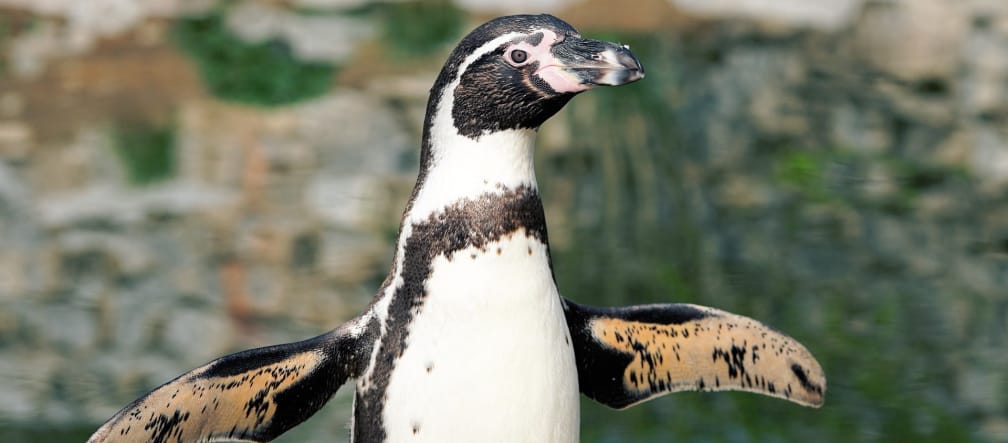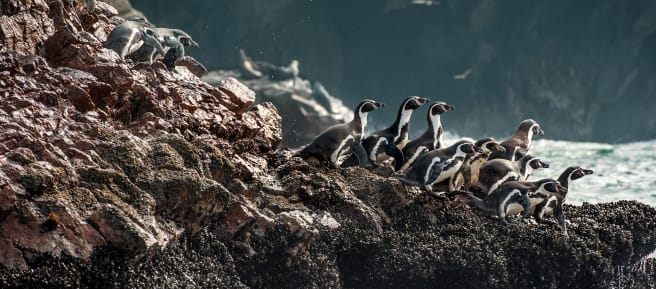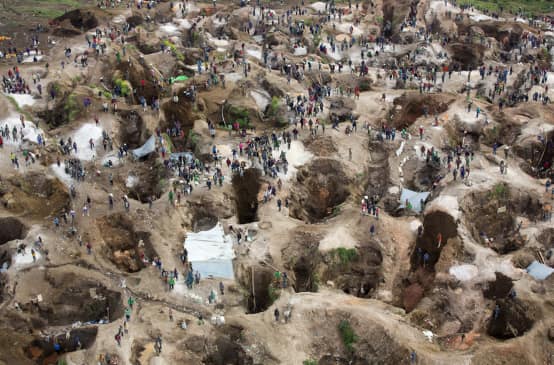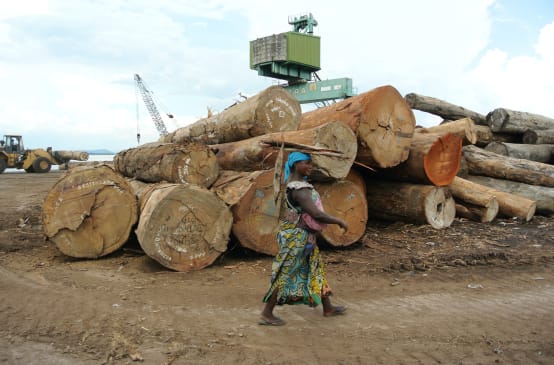
Completed campaign
Speak out for Chile's Humboldt penguins!
The breeding grounds of the endangered Humboldt penguin off the northern coast of Chile are in danger: a mining company is planning an industrial port in the area to ship iron ore. Chilean environmentalists are working to establish a protected area, and they need your signature to help save the penguins’ home!
News and updatesTo: Chilean President Michelle Bachelet, Environment Minister Marcelo Mena Carrasco
“Put the habitat of the Humboldt penguins under strict protection and apply for a UNESCO World Heritage Site listing for La Higuera/Isla Chañaral.”The La Higuera/Isla Chañaral marine region is outstanding in its biodiversity. It is home to whales and dolphins, and the rare Humboldt penguin raises its young on the islands off the coast of Chile. Around 80 percent of the world’s Humboldt penguins live and breed there. The region has been recognized as one of the planet’s 35 biodiversity hotspots.
Andes Iron, a mining company, has little interest in such biological treasures. It plans to establish open-pit mines in the region and build an industrial port in Totoralillo Norte to ship iron ore to international customers. The port would not only destroy the habitat of the penguins, but disrupt the entire ecosystem.
Andes Iron’s port is not the first such project in the region. For more than 20 years, plans to build coal power plants, mines and harbors have threatened the abundant marine area, while calls by environmentalists for protective measures have not been adequately considered.
Now there is reason for hope. Responding to local protests, the regional government has spoken out against Andes Iron’s port plans – a tentative success for the penguins! We now want to use this momentum to put strict protection in place for La Higuera/Isla Chañaral and have the marine region listed as a UNESCO World Heritage Site.
Time is tight, however: Andes Iron has announced legal action against the regional government’s decision.
Please sign our petition and help us bring as much international pressure as possible to bear to protect the penguins!
Help is within reach
Local protests against the mining company’s projects have been heard, and resistance is mounting in the northern Chilean region of Coquimbo. Here are some impressions of the protests in February 2017:
Initial protection measures
The marine area off the Chilean coast is incredibly biodiverse because of the cold upwelling waters of the Humboldt current. While the existence of this natural treasure has been recognized, it has not been adequately protected. Two small marine reserves (Reserva Marina Islas Choros y Damas and Reserva Marina Isla Chañaral) and the national Humboldt penguin reserve (Reserva Nacional Pingüino de Humboldt) are tightly demarcated protective areas that only provide a one-kilometer buffer around the breeding penguins’ islands. They are home to 13,000 breeding pairs – or 80 percent of the total population of the vulnerable species (Spheniscus humboldti). This patchwork of protected waters does not reflect the realities of the penguins’ habitat, however.
In 2010, the environmental NGO Oceana called for the creation of a larger, contiguous protected area to address these shortcomings. Oceana continues to advocate declaring the particularly valuable coastal and marine region between Caleta Chañaral de Aceituno and Caleta Hornos (3,445 square kilometers of sea area, 294 km coastline) to be a marine protected area (Área Marina y Costera Protegida de Múltiples Usos) to protect the endangered species and preserve the treasures of the ocean for Chileans and visitors. Chile would thus fulfill its international obligations.
The demand: a marine protected area and World Heritage Site
The official declaration of a large, contiguous marine and coastal region as a “protective zone with multiple uses” (Área Protegida Marina Costera de Usos Múltiples) would achieve two goals:
1. The area’s biodiversity would be protected.
2. The zone would be open for sustainable, legal uses such as coastal fishing and the harvesting of shellfish. Both are currently practiced by locals. A protected area would thus safeguard their livelihoods. Other legal usage would include sports, recreation and ecotourism.
Five good reasons for a protected area
1. The area is the habitat of numerous rare and endangered animal species such as the bottlenose dolphin (Tursiops truncatus), the sea otter (Lontra felina), the Peruvian diving petrel (Pelecanoides garnotii) and 80 percent of the remaining population of the Humboldt penguin (Spheniscus humboldti).
2. The cold upwelling water in this marine area results in a high productivity of small organisms that provide a source of food for many aquatic mammals, fish and birds.
3. The zone would permit fishing and the harvesting of shellfish in quantities that are not possible in other regions of Chile.
4. Income from tourism, fishing and the sale of shellfish would secure the livelihoods of local families.
5. The region is highly interesting for tourism. The number of summer visitors has risen steadily in recent years. According to the Chilean conservation authority, around 40,000 tourists visited the area in 2015.
Five hopes for improved protection
1. Support for a La Higuera/Isla Chañaral protected area and its recognition as a UNESCO World Heritage Site is growing. The regional environment ministry is now among the supporters of the proposal.
2. The 4th International Marine Protected Areas Congress (IMPAC4) will be taking place in La Serena, Coquimbo, from the 4th to the 8th of September 2017. Around 2,000 international experts will be coming together in the immediate vicinity of the penguins’ habitat to discuss “bringing the ocean and people together”. Our partner Sphenisco e.V. will be calling on the participants of the congress to pass a resolution advocating the lasting protection of La Higuera/Isla Chañaral.
3. Last year, more than 225,000 people around the world supported our petition to protect the Humboldt penguins. Since then, opposition to the current port projects has been growing in Chile and internationally.
4. A group of experts under the leadership of the Chilean conservation authority CONAF is developing a national plan for the conservation of the Humboldt penguin. Sphenisco e.V. is also represented in the group.
5. The MODEMA citizens' initiative and the Oceana conservation organization are currently taking legal action against the approved port in Cruz Grande. If the decision in favor of the environment and against the port in Totoralillo Norte is overturned, they will also be taking appropriate action against it.
-----
This video shows the perseverance of the penguin protectors. The marine region and thus the existence of Humboldt penguins has been in jeopardy for decades. We are therefore calling for a strictly protected area and its recognition as a UNESCO World Heritage Site. These moves are crucial to the survival of the Humboldt penguins.
-----
Environmentalists from Chile and Europe wrote the following declaration in 2016. Their current demands go well beyond those of the original declaration.
La Higuera-Chañaral Island Declaration
La Serena, 25 January 2016
Through great concern for the biodiversity of the coastal region of La Higuera/Chañaral Island, and the wellbeing of the residents of the region, Sphenisco e.V, natural protection organizations, and friends of nature throughout the world are turning to the responsible parties in Chile, as well as the Chilean and international public. The cause of the concern is the current review of the Dominga Project from the company Andes Iron through the Servicio de Evaluaciõn Ambiental of the Coquimbo Region (the governmental organization responsible for environmental impact statement reviews, hereinafter SEA).
Between August 2012 and January 2015, this same SEA reviewed the application of the company CMP (Compania Minera del Pacífico S.A.), for a port project in the La Higuera/Chañaral Island area, and did so in an improper and insufficient manner, with the result that the project was approved. As a result, legal suits have been brought against this decision and are currently in process. This port is intended to be built in a marine region that houses numerous threatened species. Eight species of whale and nine species of dolphin regularly visit this area during their seasonal migrations, and use this area as a source of food. 70 Common bottlenose dolphin (Tursiops truncatus) live here permanently. This is the only group of this species that lives throughout the entire year in Chile. Here lie two marine protection areas: the Reserva Marina Islas Choros y Damas and the Reserva Marina Isla Chañaral and theNational Protection Area of the Humboldt Penguin (Reserva Nacional Pingüino de Humboldt).Together, these areas are the first and only protection areas for Humboldt Penguin on the planet, where approximately 13,000 breeding pairs live. These penguins represent 80% of the entire wild population of the threatened species of the Humboldt Penguin (spheniscus humboldti).
Although the marine areas of La Higuera/Chañaral Island in northern Chile are one of the 35 most important hotspots of biodiversity on the planet, that are particularly worthy of protection, the company CMP was not required to make any statements regarding the project’s impact on the environment. Thus the company was able to ignore the fact that the coastal area between Caleta Hornos and Chañaral Island is one unified ecosystem. CMP therefore did not have to answer to the impact on the federally-declared marine protection area that would be only 14 sea miles away. Nor did CMP have to answer to the 15 state-protected areas set up for the harvesting of shellfish, that would also be potentially endangered by the presence of a port at the intended location. The responsible governmental authorities pointed out the connection between the port and the danger to these protection areas from the very beginning of the review process, and required that the company address the impact of the environmentally-damaging emissions from the ship traffic that would result when the water currents transport the pollutants there. This requirement was not addressed in the environmental review and the project was nevertheless approved! No conditions were imposed upon CMP, as were demanded by the regional Sernapesca (the regional fishery authority) and Subpesca (the Undersecretariat for Fisheries and Aquaculture), such as rules for ship traffic or control measures to prevent the introduction of invasive species, etc.
Only the Regional Secretary for the Agriculture saw the causal relationship between the port project and the environment, and therefore voted against it. This situation functions as a portent of something calamitous and throws a peculiar light onto the political situation in Chile, when the dissenting vote resigns five days after the project’s approval, claiming alleged problems of a personal nature made the ability to remain in office impossible. When powerful interests are at play, reality has to step back (see also Letter to the President, from Coquimbo, 12 February, 2015).
It is feared that the current review of the Dominga Project (for the Company Andes Iron) will again not go through a thorough and correct examination of the environmental impact, and that the marine regions of La Higuera/Chañaral Island will be irreversibly damaged. It must not again be disregarded that
1. the planned port facility of Totoralillo Norte, also to be in the immediate vicinity of the main feeding area of threatened species such as the Humboldt Penguin (spheniscus humboldti), the sperm whale (Physetet macrocephalus), the Peruvian Diving-petrel (Pelecanoides garnoti) and that the ship traffic will also be routed through this feeding area.
2. the noise and vibrations of the expected ship traffic in an area, where for over the last 50 years no large ship has traveled, will have a negative impact on the breeding areas and therefore also disturb the reproduction of the affected species.
3. the Humboldt Stream flows from south to north and thus into the protected areas, and not, as the company attempted to maintain, from north to south. Therefore, the results of the expected emissions must be taken into account when conducting the environmental impact survey, and primarily the oil and fuel from the ships, the iron ore that falls from the ships and contaminate it, the release into the sea of concentrated salt brine from the planned desalinization plants, as well as the results of any potential ship accidents. These emissions would strain the water quality and endanger the designated protection areas, as well as the 15 managed shellfish harvest locations and five locations where aquaculture is done.
4. the planned desalinization through the sucking up of water from the sea would destroy many organisms that are the basis of the productivity of this marine area.
5. the danger of the significant productivity of this marine area would also endanger the livelihood of the citizens there. The current productivity allows the residents to generate meaningful revenue, through fishing, the harvesting of shellfish, and through tourism.
If the SEA continues with the motto, “the company Andes Iron is building a port, and the ship traffic and the emissions spread in the marine current have nothing to do with it”, they breach their own duties and allow private interests to dominate the common good. That would result in irreversible damage to the biodiversity in the marine areas of La Higuera/Chañaral Island, endanger the earnings of the residents of the area, and result in the country of Chile contravening its international commitments.
We call for the politically responsible parties to assess the Dominga Project (for the Company Andes Iron) based on real, objective conditions, and to review the approval process of CMP’s Cruz Grande port for irregularities.
To: Chilean President Michelle Bachelet, Environment Minister Marcelo Mena Carrasco
Madame President,
Minister Marcelo Mena Carrasco,
Ladies and Gentlemen,
La Higuera/Isla Chañaral marine area in the Coquimbo region is one of Chile’s outstanding natural treasures and one of 35 global biodiversity hotspots. It is the habitat of the Humboldt penguin, which has been classified as vulnerable by the International Union for Conservation of Nature (IUCN), as well as numerous other animal species.
For the past twenty years, this priceless ecosystem has been endangered by various industrial projects. The current threat is a planned harbor in Cruz Grande. While the harbor has been approved, environmental activists are suing to overturn the ruling. A harbor that was planned for Totoralillo Norte was fortunately rejected by the regional government in Coquimbo.
Since 2010, the environmental NGO Oceana has been advocating the establishment of a marine protected zone with a variety of uses. Chilean scientists and other experts also consider this to be a crucial move.
The time has come to put solid, lasting protections in place for these irreplaceable natural wonders.
Together with environmentalists from around the world, we urge you to exercise your responsibility for the La Higuera/Isla Chañaral coastal and marine region. We call on you to declare it a protected area and to apply for its recognition as a UNESCO World Heritage Site.
Most respectfully,


